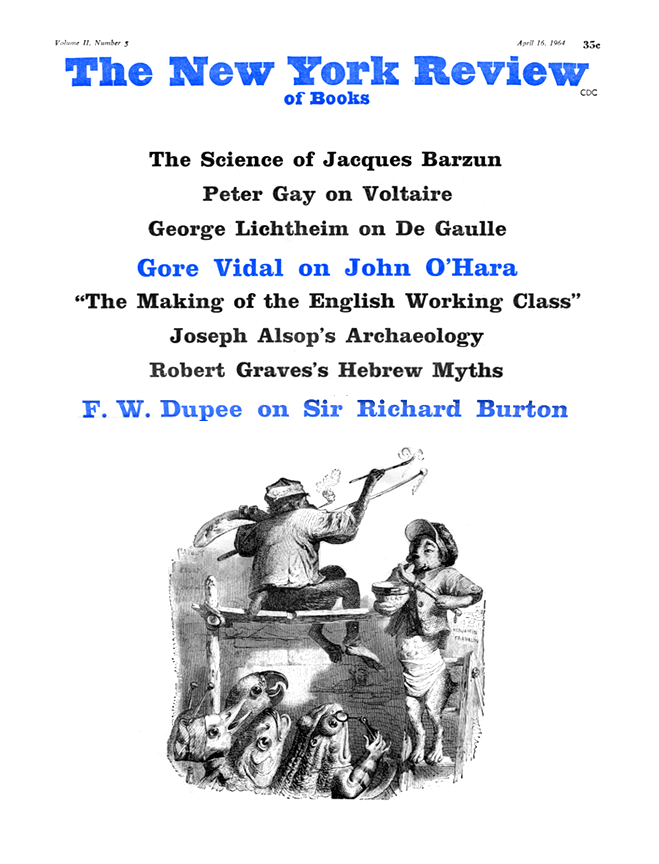In response to:
On The Dial from the February 20, 1964 issue
To the Editors:
At the end of the introduction to The Time of The Dial, I remark that my aim is not to say the last word but to reopen a conversation. And Lewis Mumford, reviewing this book and my Dial Miscellany (February 20, 1964), has responded. Mr. Mumford is a man whose work and character I cherish. His views on The Dial, however, represent one of the well-established positions which my own work is designed to modify and supplement. Lest your readers decide that the matter is closed, I must respond to certain central complaints.
The term “organicism” I do not “extend” to the New Humanists. Having found it in their vocabulary, I report and analyze its meaning in the minds of members of this literary group, of other groups to whom the word has special weight. The phrase “crusading spirit of 1910,” which Mr. Mumford rejects, is adapted with citation from Alfred Kazin. Had Reed Whittemore’s essay on little magazines been available, I’d have cited, too, his description of the “incurably utopian,” “civilization-saving” spirit of that day. That this spirit applies to The Dial is not my opinion only but is held by Daniel Aaron and reported in his study of this and related issues, Writers on the Left.
The rhetoric which Mumford does not admire and which he describes as “having an archaic religiosity” suited to “the Brook Farm experiment,” not The Dial, is drawn from the man, Randolph Bourne, whom Mumford does not accept as The Dial’s source of inspiration. In 1917 Bourne wrote: “We shall never be able to perpetuate our ideals,” the world “will never understand our spirit except in terms of art. When shall we learn that ‘culture,’ like the kingdom of heaven, lies within us, in the heart of our national soul.” Scofield Thayer, at that time a crusading socialist and pacifist, tried to take over The Seven Arts in order to enable Bourne to broadcast these ideas. When that first plan failed, he turned to The Dial as a second means to the same end. Bourne died in 1918 but, I contend, Thayer did not forego these aims. The contention is supported by diverse data the most succinct of which is S. Foster Damon’s opinion of Thayer’s Dial as a “Seven Arts without politics.” Had I suspected that evidence describing the magazine’s tone or the editor’s idiom was skimpy, I’d have included more recent remarks in reminiscence by The Dial’s art critic Henry McBride, who described his own labor as “missionary work” in behalf of American art: “In fact, looking back…I can scarcely repress a smile at the lengths to which The Dial sometimes went” in its “continual pounding on the desk for its protegées,” American and European. Reading an editorial on Marianne Moore, McBride heard echoes of a “fervor and assurance” which “sounded for all the world like Scofield Thayer of The Dial in the old days.”
When Mumford, therefore, discredits “the part that Randolph Bourne’s spirit played in molding the kind of review that Thayer and Watson actually edited,” and substitutes as “the spiritual father of The Dial” Thayer’s old teacher, Santayana, I can say only that I disagree. Thayer is after all the editor of a magazine which in 1923 presented its annual Award (for “service to American literature”) to Bourne’s friend and disciple, Van Wyck Brooks, and later announced that Brooks is a man of “supreme importance” even if one is unable “to accept the whole body of his doctrine.” And Thayer is also the man who, shortly before his retirement as editor in 1925, before he selected Marianne Moore as his successor, offered his post—offered The Dial to Van Wyck Brooks.
Having written at length of these persons and projects, I had thought that my book offered some enlarged understanding of the motives, implicit rather than explicit, which led Thayer to refurbish The Dial. Having thought, too, that I had accounted for Santayana’s role, I decided against using a letter written by Santayana to Brooks in 1927. Published in 1955 it illustrates why I am unable to share Mr. Mumford’s opinion of these matters. Santayana, protesting against the Bourne-Brooks position in American letters (though, as he remarked, he hadn’t read Bourne), ended saying: “I therefore think that art, etc. has a better soil in the ferocious 100 per cent America than in the Intelligentsia of New York. It is…aestheticism, art museums, new theaters that make America impotent. The good things are football, kindness, jazz bands.”
Surely Thayer, creating his new magazine, had long outgrown his old teacher and had found in New York’s leading intellectual, Bourne, a master, a rhetoric, a fervor, a program better suited to his taste.
William Wasserstrom
Syracuse University
Syracuse, N.Y.
This Issue
April 16, 1964


